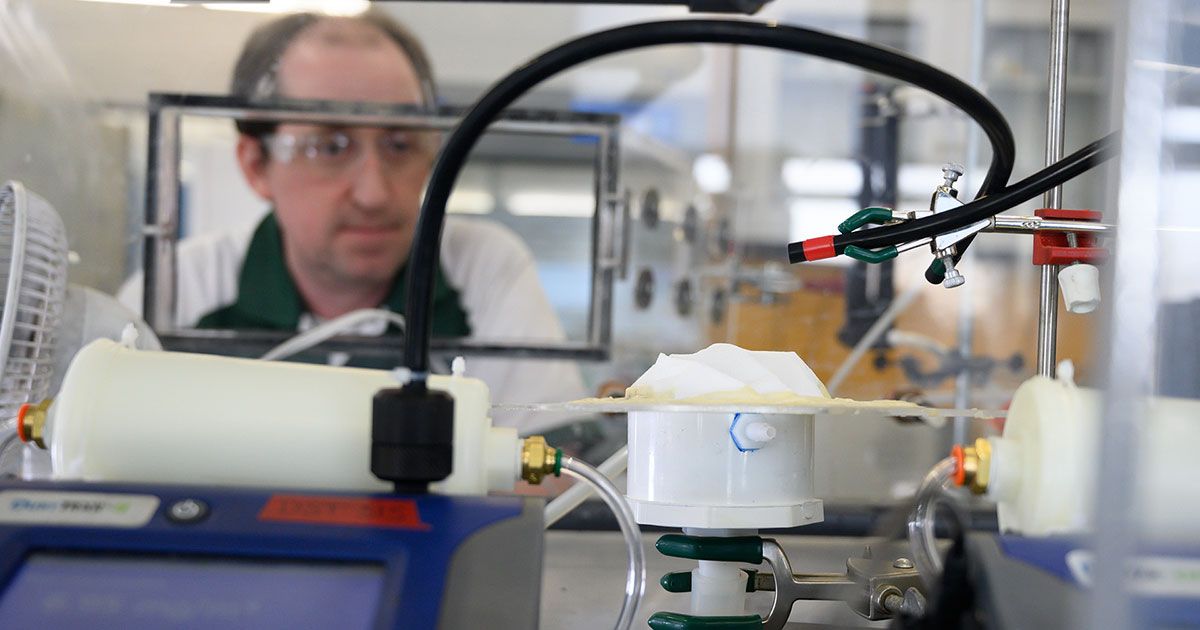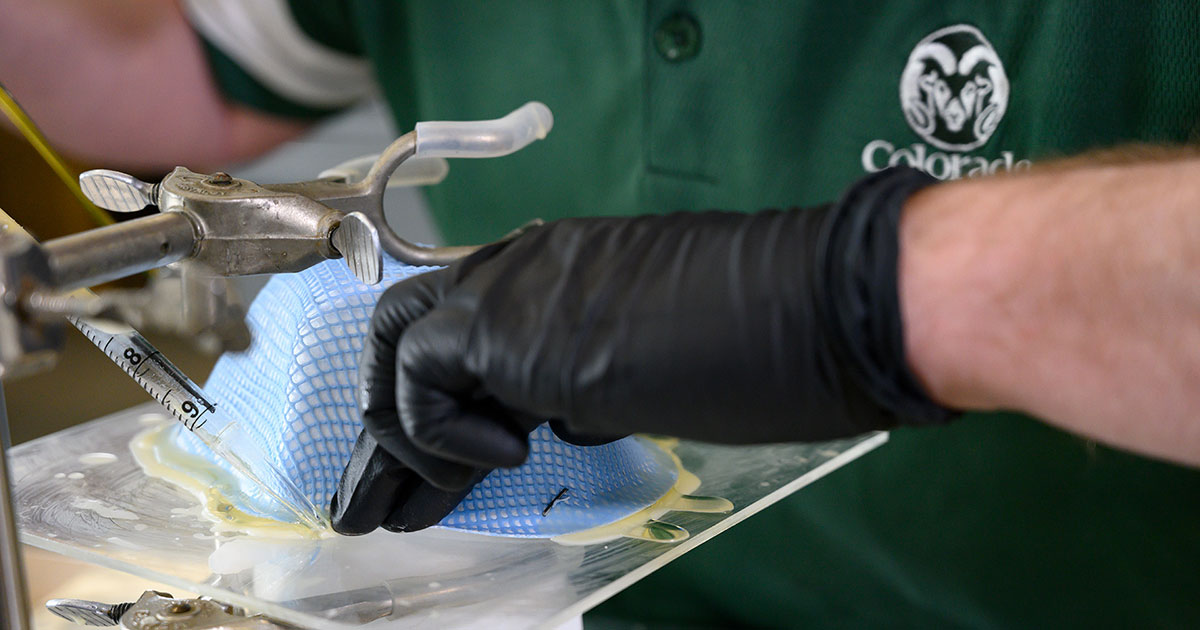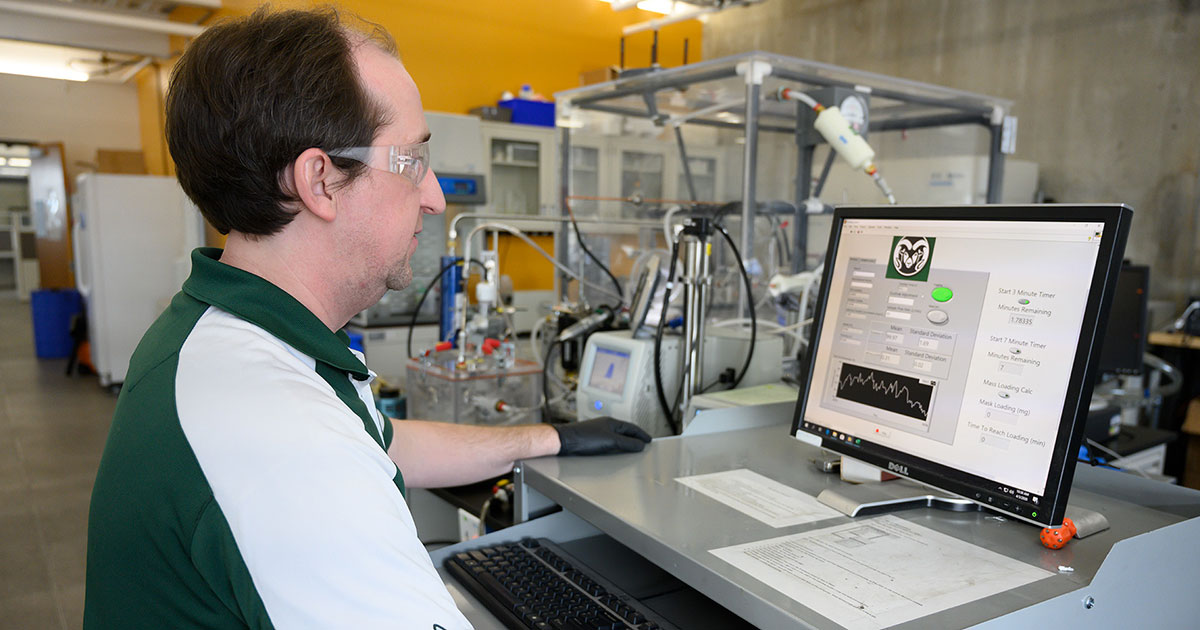Learn how a CSU lab is ensuring that protective masks for health care workers meet federal safety standards. Video by Ron Bend.
Professor John Volckens’ 2,000-square-foot lab on the campus of Colorado State University is normally a place for experiments on air quality, pollution sensors, and how breathable particles can trigger disease.
Over the last two weeks, the lab has suspended most of its usual activities and transformed into the official testing site for respirators and surgical masks for distribution throughout the state of Colorado. These forms of personal protective equipment are critical for ensuring the safety of front-line medical workers who are battling COVID-19 every day.
On March 25, Gov. Jared Polis announced that CSU, and specifically the Center for Energy Development and Health which Volckens leads, is the state’s designated center for evaluating the safety and efficacy of protective gear, mostly medical masks, that are made by different vendors and sources and are destined for Colorado hospital workers. CSU’s role is to initiate and coordinate testing and provide recommendations to the state on distributing such equipment. Primarily, the CSU team is focused on N95 particulate respirators that offer certified protection from aerosols in the workplace.
The only federal lab that regularly performs this type of N95 testing is in Pennsylvania. The state of Colorado has now designated CSU as, essentially, an emergency substitute for standard federal testing, to be done in-state for in-state needs.

Researcher Christian L’Orange prepares a mask for testing. Photo by Bill Cotton.
Shoring up supplies
The state estimates between 60,000 and 100,000 disposable masks and other protective items, per day, will be needed for Colorado healthcare workers in coming weeks and months. In an effort to stave off shortages, the state has kicked into high gear to stockpile supplies, and CSU is at the forefront of making sure the masks in particular will work to specifications.
“Our lab has the facilities and engineering expertise to perform those tests,” said Volckens, a professor in mechanical engineering and environmental and occupational health. “We can essentially mimic the stringent requirements put forth in the federal protocol.”
What is an N95 respirator?
To be designated an N95 respirator, a mask must pass a specific federal safety inspection that includes 95% or greater filtration efficiency for particles that would normally be inhaled. Meant to form an airtight seal over the wearer’s face, these respirators must offer a high level of breathability so that they can be worn continually across a work shift. They are indicated for use when treating patients with diseases that could be transmitted by aerosolized particles, including COVID-19, which is believed to spread through both large airborne droplets and smaller, breathable particles.
Volckens and his team have toiled furiously since March to get the lab ready to run mask tests, as shipments come in from various vendors. For any given type of mask, it can take several hours to complete a test.
N95 test steps
The N95 inspection involves a number of steps, said Christian L’Orange, a CSU professor of research practice who is performing the majority of the tests. First, the mask is conditioned at a set temperature and relative humidity, then sealed down to a fixture. The mask is then placed in an environmental aerosol chamber, where particles are drawn through it. Sophisticated equipment is used to count the number of particles upstream and downstream of the mask, as a measure of its efficiency. The researchers must also perform a breathability test, because the mask’s safety is tied to how easily the wearer can breathe through it.
“It’s not just about how well it filters,” L’Orange said. “A mask with too much of a pressure drop actually puts too much burden on the person breathing through it, which can be downright dangerous.”

L’Orange seals a mask to a frame with beeswax to prepare it for testing. Photo by Bill Cotton.
The N95 tests simulate real working conditions with high dust loadings, which can include viral particles. The researchers are following National Institute for Occupational Safety and Health protocols for N95 masks, which are used in many trades and occupations – not just health care.
“It’s a worst-case scenario test,” Volckens said.
The testing looks at particle penetration only, not fluid spills or splatters, Volckens added. To test each lot of masks that comes in, the researchers will take a statistically valid sample and require that every mask in that sample pass quality standards, adhering identically to those published by NIOSH.

During testing, researchers monitor values of particle filtration efficiency for each mask. Photo by Bill Cotton.
In the lab, L’Orange is leading overall procedure design, and lab manager John Mehaffy is prepping masks for testing. Postdoctoral researcher Jessica Tryner is performing data analysis so that results can be immediately processed and shared with the state. The team operates from different locations in order to limit personal contact and further protect their health.
“We don’t know how long this need will go on, but we will continue to serve the state until they tell us we’re in good shape and we can stop,” Volckens said.